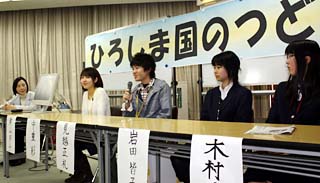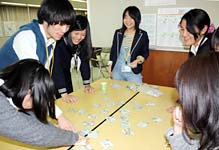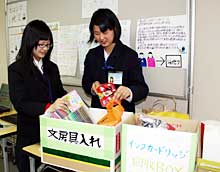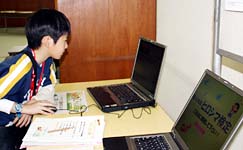Peace Seeds Gathering
United in our desire for peace
The first 窶弃eace Seeds Gathering窶・was held on March 26 at the Chugoku Shimbun headquarters in downtown Hiroshima to raise awareness of Peace Seeds and the junior writers. About 100 people came to the event, including former junior writers and educators from the community.
A discussion took place which involved current junior writers interacting with former junior writers about the things they had learned from their participation in Peace Seeds. One former junior writer now studying at a university in the United States took part in the discussion through a video conferencing link over the Internet, and there was an active exchange of views among the participants.
Those who attended the event could also enjoy the handmade game 窶弃eace Karuta窶・(窶很aruta窶・is a traditional Japanese card game) as well as a 窶弉uiz on Hiroshima and the Atomic Bomb.窶・Another quiz involved articles from past issues of Peace Seeds, displayed on panels around the room. A donation box was also offered to collect contributions for the survivors of the Great Eastern Japan Earthquake, and a substantial sum of money, and stationary supplies, too, were received.
The gathering was a change of pace from writing articles, and we felt the fun and importance of interacting with our readers and engaging in heart-to-heart discussion about our work.
 Current junior writers interact with former junior writers
Current junior writers interact with former junior writers
Ties formed / Studying abroad to appeal for peace / Sustaining hope for peace / Interview regrets / Kindness is key
In the discussion, the junior writers shared how their thoughts concerning peace had been fostered through their experience of Peace Seeds and how that experience had influenced their lives.
| |||||||||
 The participants share what they learned and gained from their experience as junior writers. | |||||||||
・晃hat reporting assignment or article left the strongest impression on you?
Ayaka:When I interviewed an atomic bomb survivor, I saw a scar on her forehead from the atomic bombing. She must have endured a lot of hardship, but she spoke to me with a sunny look on her face. Seeing the contrast between the scar and her sunny expression, I felt very moved.
Masanori:I have a vivid memory of my interview with the film director Hayao Miyazaki. I was only able to ask him the questions that I had prepared in advance, and I really regret that. I don't want you to be shy about asking questions.
Minako:We put out a call for readers to send in letters of invitation for U.S. President Barack Obama, asking him to visit Hiroshima. Our friends around us became involved in the project, too, and I felt that ties were made among many people. Moreover, that project led to another activity, establishing the 窶廸o Nuke Network,窶・a group made up of junior high and high school students in Hiroshima which is working for the abolition of nuclear weapons. I'm taking part in this effort, too.
Kyoko:I was impressed with Miho Cibot, a peace activist in France, a nation which holds nuclear weapons. I've lived in the United States for three years now, but doing this work in foreign countries is very challenging. So I really respect her.
Yuumi:On August 6, I asked an A-bomb survivor to answer our questionnaire, but I don't think I handled the request well and the person refused. I'm afraid I hurt her feelings. Another time I was asking people to make a smiling pose for a picture in Peace Memorial Park, but I thought it might strike the survivors as strange.
・晃ere any of you influenced by your Peace Seeds experience in terms of deciding what to do after graduating from high school?
Kyoko:I decided to go to the United States after being influenced by the people I met for interviews for Peace Seeds. They were making efforts to convey their thoughts for peace to the world through a variety of means, such as photography, animated films, and songs. I thought it was important for me to study hard at a university overseas in order to appeal for peace.
Minako:I became a junior writer because I was thinking I wanted to be a journalist, but through the interviews I conducted, I've grown interested in international issues. Now I want to do some kind of work that will help change the world.
・好id your thinking about peace change, from before and after you began working as a junior writer?
Kyoko:I came to see that peace doesn't simply equal working for the abolition of nuclear weapons. Many factors are important for peace, such as problems involving the environment and poverty. People in America know about the atomic bombing of Hiroshima, but most of them aren't aware in any detail of how much damage there was and how many people have suffered from the aftereffects of the bomb. When I try to explain these things, some people refuse to listen. My feeling is it's very different appealing for peace in Hiroshima, where people are strongly aware of these issues, compared to other countries.
Ayaka:Through my experience with Peace Seeds, I learned the importance of speaking to others with respect and kindness.
Yuumi:Before I became a junior writer, I thought that the world today was a peaceful place. However, I found that there are many problems, such as children in the world who don't have enough to eat. The world isn't as peaceful as I thought.
・晃hat can we do to help make the world a more peaceful place?
Yuumi:Peace will come if we keep on working for it. I want to continue doing my best as a junior writer, taking pride in my work.
Kyoko:Knowledge is vital, but taking action is important for anything you desire. I hope you'll continue moving forward, step by step.
Masanori:In your work for Peace Seeds, you have opportunities to meet people you wouldn't normally meet, and go to places you wouldn't normally go to. I encourage you to do the things you really want to do.
 Peace Karuta
Peace Karuta Excitement in the air
Excitement in the air
 People enjoy a game of 窶弃eace Karuta.窶・/div> |
In the area featuring the game 窶弃eace Karuta,窶・the table with the 窶很aruta窶・cards was always surrounded by about ten people, and many of those that attended the event tried their hand at the game. There was excitement in the air, with the sound of cards being slapped, hands clapping, and people laughing heard from across the room.
窶弃eace Karuta窶・was originally created for the issue of Peace Seeds published in December 2010. The reading cards convey messages appealing for peace from Hiroshima, including messages from the professional baseball player Takahiro Iwamoto of the Hiroshima Carp, the junior writers, and others. The drawings for the picture cards were made by a former junior writer.
Maho Kawano, 11, a sixth-grader at Kaitahigashi Elementary School, said, 窶廬t was fun to play the game with a lot of people. I want to think about the idea of peace again.窶・(Arisa Shiromoto, 15)
|
People of all ages gave it a try
In the corner that offered the 窶弉uiz on Hiroshima and the Atomic Bomb,窶・people of all ages, from children to adults, gave the quiz a try. There were three computers to take the quiz. The quiz has a total of 20 questions, including easier questions such as 窶弩hat year was the atomic bombing?窶・and 窶弩hy has the Atomic Bomb Dome been preserved?窶・as well as more difficult questions. The questions were all devised by the junior writers and they were first introduced in issue #33, which was published in July 2008. We observed people who expressed delight with a perfect score and others who fretted over mistakes. Naoko Koizumi, 54, an interpreter, said, 窶廬'm often asked many of these questions by visitors from abroad, so I think they're quite useful. I'd like to make use of this information in my work.窶・(Mei Yoshimoto, 14) |
 Peace Seeds Quiz
Peace Seeds Quiz Learning from articles
Learning from articles
 Participants searching for quiz answers in the Peace Seeds articles on display. |
Another quiz involved articles from Peace Seeds, and junior writers distributed the quiz sheet at the reception desk. The quiz consisted of five multiple-choice questions, such as 窶弩hat are the U.N. colors?窶・and 窶弩hich type of power generation is not considered clean energy?窶・The participants tried answering the questions by searching for hints in the Peace Seeds issues that were displayed around the room.
Tomoharu Kadowaki, 9, a fourth-grader at Nakajima Elementary School, was eagerly trying to answer the quiz questions. He said, 窶廬'm reading the articles, looking for the answers I don't know, so I'm learning a lot. It's fun.窶・(Reiko Takaya, 13)
|
A corner for beverages was also made available and those in attendance could try fair trade coffee and tea imported at a fair price from developing countries. The junior writers prepared Brazilian organic coffee and Kenyan red herb tea, a mix of dried hibiscus and lemongrass. One of the issues of Peace Seeds on display, issue #17 published in October 2007, featured a story on fair trade. People enjoyed drinking coffee and tea with a pleasant aroma and color. Naomi Teranishi, 46, an office worker, was drinking coffee and remarked, 窶廬 hope fair trade goods become more widely available.窶・(Minako Iwata, 17) |
|
Questionnaire for Visitors |
|
| Visitors show strong interest in children窶冱 rights and bullying | |
We distributed a questionnaire to visitors asking their impressions of Peace Seeds and their thoughts on peace.
To the question 窶弩hich issue covered in Peace Seeds left the strongest impression on you?窶・ we received 17 responses. The largest number of people, six, mentioned the issues which featured the theme 窶彡hildren's rights.窶・We also learned that some readers were shocked by issue #45, which focused on human trafficking and the low percentage of school attendance among children in Africa. A 43-year-old woman wrote: 窶廬t was a good article, enabling me to reflect on my own small life in the world.窶・And another visitor wrote: 窶廬 never imagined that there are children being injected with drugs to force them into working long hours.窶・/p>
Issues #58 and #59 about 窶彙ullying窶・drew attention, too. A 39-year-old woman wrote: 窶弋here was a bullying problem at my daughter窶冱 school and the junior writers窶・ideas were very helpful.窶・Articles on the problems of junior high and high school students, written by those of the same generation, attracted the interest of readers.
Meanwhile, three people noted their interest in our coverage of environmental issues, such as water pollution and clean energy. One person wrote: 窶弋he recent earthquake in eastern Japan has made us think about the importance of water. For the first time, I thought about environmental issues as one factor that influences peace.窶・/p>
The question 窶弩hat, to you, is a peaceful world?窶・yielded a number of different answers: 窶廣 world connected by compassion窶・(a 39-year-old woman); 窶廣 society where people can find, and share, their personal happiness窶・(a 53-year-old man); and 窶廣 world where both children and adults can smile窶・(a woman).
 Stationary supplies donated by visitors. |
We also asked 窶廬n order to build a peaceful world, what should junior high and high school students do?窶・The responses we received included: 窶廛evelop a broad outlook and a variety of viewpoints窶・(a 48-year-old man); 窶弋ake action where you think it is needed窶・(a 51-year-old man); and 窶廡ind opportunities to listen to the accounts of war survivors.窶・(Kana Kumagai, 16, and Masataka Tanaka, 16)
 |
Donated stationary supplies to be sent to earthquake-stricken area |  |
A collection box at the reception desk brought in 37,676 yen in donations for people in the earthquake-stricken area and we donated all the funds to the Chugoku Shimbun Social Work organization. Stationary supplies were also collected, including new pencils and notebooks, and were donated to the people of Iwate Prefecture through an organization located in the city of Onomichi. In addition, 150 ink cartridges and 190 postcards and other supplies (second-hand, mostly) consisting of pencil cases, scissors, and memo pads were sent to two organizations handling such items.
| Photos were taken by Miyu Sakata, 15 and Masaya Obayashi, 14 |

